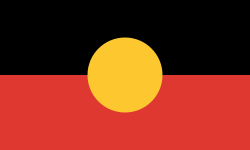I tried to capture the two flags, side by side, but it was windy and cloudy and the photos I took are fuzzy and don't reveal much. So just try to imagine it for yourself: the Harbour Bridge, one of the most iconic structures of modern Australia, with the Opera House at its southern feet, Sydney's hallmark and imprint on the world-stage, upholding these two official flags of Australia, and the various meanings and significance this has and could have. Though the Aboriginal flag is not always standing on the top of the Bridge, next to the common Australia flag, it was up yesterday, a reminder of the age of this land and of the ancient people who trod upon it for thousands of years. And so the two flags displayed, in iconic manner, the two sides of Australia.
On my first winter birthday, last Tuesday, Luke and I visited these two sides, standing side by side, but, it appears to me, overlooking each other. In the morning, we stepped onto the ancient land of Guringai, just north of Syndey in the Ku-ring-gai Chase National Park.
We began our trip by heading north to West Head, a rock and lookout just outside of Sydney, from where one can see the central coast, Palm Beach (the last northern beach in Sydney) and the Pacific Ocean. Just before the lookout at West Head, a footpath leads you to an ancient aboriginal site, where rock drawings have been found.
As we approached this footpath, we saw that two school busses were parked and children were being huddled to this monument on a school excursion. We continued toward West Head, hoping that by the time we return, the children will have moved on.
Here are some photos from West Head:
Partial views of Lion Island and the Central Coast:

Luke with Palm Beach in the background (the northernmost point of Sydney):

Lion Island:

On our way back, the children had gone, the path was empty, with only a sign indicating that aboriginal drawings have been found here, and an arrow pointing us in the right direction. It was only 400 metres from the entrance to the path, and so we walked slowly, studing the plants around us.
Soon enough, Luke found a small path leading toward rocks. There were no indicators, which was suprising, but I followed. The rocks were large, grayish with pink undertone, but it was hard to make out any drawings on them. They were carved out, however, and these carvings did not appear natural. It looked as though the carvings functioned as water channels. We inspected these rocks and walked through the bush around them, and, in the warmth of the winter sun, I was spellbound. The age of this land does not often enter my mind, the fact that we live in and are surrounded by rocks that were made into water channels thousands of years ago, is absent to my everyday consciousness. But for a short time, as we walked ontop of and around these rocks and studied the ever-blooming plants, their presence did not feel lost.
But this was not enough. We both were dissatisfied with what we'd found: the rocks were carved, but the carvings were not drawings. So we decided to continue on our original path, to see if there may be other, more eloquent carvings that would classify as drawings.
And indeed, within twenty metres, we found what we'd been looking for--and it was marked. On a rose colored rock, there was a sign for Guringai Land (the indigenous people of this area are called the Ku-ring-gai). Without knowing much about the land, or the people who once inhabited it, we entered the area.
It was more than anything I'd expected. I hadn't seen any ancient drawings before, but these petroglyphs are so clear, so well-preserved, that I was surprised by how easy they are to spot and to grasp... there were images of human beings, of animals (many Kangaroo), of fish (the ocean is nearby) and of the activities of hunting and fishing.


(There are many more drawings...)
When I researched the dates of these drawings, I discovered that very little is known about them, and that the present techniques of dating cannot establish with any accuracy their time-line. The guess, however, is that they may be anywhere from 20,000 to 10,000 years old. What is so astounding to me, is how little information there is, or has been found, about the people of this region. Though there is greater awareness, I think, of the indigenous people in the Australian cultural consciousness than there is of the American natives in the US (my sense), there remains much that is unknown, and possibly forever lost.
And so I delved into a book of aboriginal myths last week, not with the eyes of the inspecting anthropologist, but with the eyes of someone who wants to connect to, or find some way by which to come to understand, the people who once lived here. More on this in posts to follow...
For now, I will just say that while in the morning we experienced (in a very limited sense) the ancient history of this land, in the afternoon, we experienced (in a much more direct and stronger sense) an other side of Australia: its colonial heritage. For lunch, we went to a British-style country club with a golf course and manicured lawns! Luke's step-grandmother, who is best described by the word 'magical,' chose this location for its wonderful views of the water.
So we traversed the day from the ancient petroglyphs of the Kuringai people to 19th century British (colonial) culture, and this was, in a revealing way I think, disorienting! On the two sides of the Australian continent, we spent my first winter Birthday :)













Nice post Dalia. Enjoyed your musings and learning about your outing. Sounds like you had a nice winter (re)birthday. -David
ReplyDeleteThanks David! Winter birthday is still a novel idea...
ReplyDelete